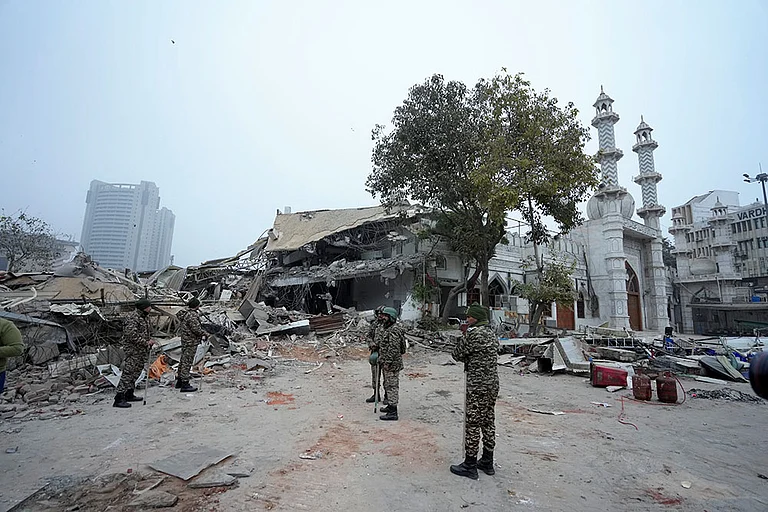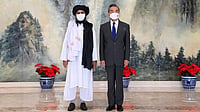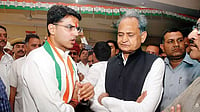“History,” according to noted British historian EH Carr, “consists of a corpus of ascertained facts. The facts are available to the historian in documents, inscriptions, and so on, like fish in the fishmonger's slab.”
“The historian,” Carr further writes, “collects them, takes them home, and cooks and serves them in whatever style appeals to him.”
As such, histories are vulnerable to distortions, and the process of distorting or reshaping history by an individual, an institution, or a political structure does not happen in a vacuum, especially in the parts of the world where the governing superstructures are motivated by ideology.
In a conversation with Outlook, Dean Accardi, Assistant Professor of History at Connecticut College, talks about history and how altering historical discourses can become dangerous. Accardi, who specializes in Kashmir’s medieval history, also talks about how the Dogras relentlessly worked to promote the notion that Kashmir’s true heritage was exclusively Hindu and how their rulership over Kashmir was “justified” as a revival of Kashmir’s real Hindu heritage. As a case study, he also sheds light on strategies employed by the famous Orientalists, George Grierson and Lionel Barnett, to recast Lal Ded—a revered woman ascetic of the fourteenth century— and the cultural heritage of Kashmir as exclusively Hindu, and how the Dogra court played its part in the project.
Edited excerpts:
Can you please tell us about Lal Ded of Kashmir and her life and identity, especially in the backdrop of the times she lived in?
Lal Ded is a revered ascetic saint of the 14th century who is said to have wandered naked across Kashmir engaged in intense spiritual practices and shared her religious teachings with prominent and common people alike. However, it is important to know that the earliest known writings about Lal Ded are found in Muhammad 'Ali Raina’s Tazkirat al-‘Arifin written in Persian around 1587, whereas the earliest manuscripts of poetry attributed to her date to the late 17th or early 18th centuries. Thus, everything we know about her comes to us at least 2-3 centuries after she is presumed to have lived.
She lived during the beginning of the Kashmiri Sultanate (1320-1586), the first period of Muslim rulers over Kashmir and the last time Kashmiris ruled over Kashmir. Thus, Lal Ded and other figures of this period are particularly cherished in Kashmiri heritage and culture. Many write about Lal Ded as a bhakti saint and popular exponent of Trika Shaivism on the basis of the poetry attributed to her, but as already mentioned, her poetry first appears several centuries after she lived. Others claim she was a devout Muslim and Sufi, while yet others claim she followed a religious life that brought together Hindu and Muslim practices. What we do know is that from the earliest records she has been associated with Nund Rishi, or Sheikh Nooruddin Noorani, founder of the Rishi Order of Sufis, who claimed to be Lal Ded’s spiritual successor and that at least from the late 17th century until today Lal Ded has held a prominent place amongst both Hindu and Muslim Kashmiris.
How are historical figures like Lal Ded brought to the fore from the past? How does a historian stay true to his facts, and away from biases?
Historical figures like Lal Ded come to the fore because people at various times hear stories about such figures that seem applicable to their contemporary lives—speaking to the social and political circumstances in which they find themselves and how they wish to respond to them. Thus, while legacies of such figures come down from the past to people of various times through writings or stories passed down from generation to generation, people with whom these stories resonate inevitably reshape those legacies to better respond to their new contexts. However, one result of such activity is that those new, reshaped legacies are then projected into the past so that these new notions come to be understood as being what actually happened or who these figures actually were. But the truth is that we really have no idea who most figures from the pre-modern past really were. We only know what different people thought about those figures within their own historical contexts. Therefore, we know what Muhammad ‘Ali Raina thought of Lal Ded (or at least what he wrote about her), and we know how Rajanaka Bhaskara understood the poetry attributed to her when he translated those poems into Sanskrit hundreds of years later. Staying true to these facts—that we can’t know her as she knew herself in her own time but only how different people have interpreted and deployed her at different times—aids in avoiding historical error and unconscious biases. Of course, that does not mean I or other scholars are just conveying the objective truth. It just means that I am hopefully aware of and transparent to my readers about how and why I understand and interpret Lal Ded the way that I do.

Can you shed some light on the research process employed by George Grierson, Lionel Barnett and Mukund Ram Shastri? Was their research motivated, and deliberately aimed to cast Lal Ded as exclusively Hindu? How accurate is their work?
For context, George Grierson and Lionel Barnett were famous Orientalists and the authors of the first major English translation of poems attributed to Lal Ded titled Lalla Vakyani published in 1920. Like most Orientalists of the time, Grierson and Barnett were steeped in the notion that Indian history was divided into three eras—Hindu, Muslim, and British—and thus that India’s true cultural heritage was as a Hindu civilization that entered into a Dark Age under Muslim rule and that British rule was there to aid India in recovering it prior glory and modernizing it for the present day. Rudyard Kipling’s “White Man’s Burden” expressed this shared imperialist sentiment starkly. The impact of this preexisting conceptual framework on conceptions of Lal Ded is that Grierson and Barnett were already predisposed to thinking that any religiously-ambiguous figures revered by both Hindu and Muslims must have originally been Hindu and only later adopted by Muslims. Thus, they privileged the poetry attributed to Lal Ded as who she really was despite it appearing later, and they dismissed any accounts of Lal Ded—especially those written by Muslims—as secondary attributions to be dismissed if they did not align with the poetry. Likewise, any poems attributed to Lal Ded that seemed to indicate she may have not been primarily or exclusively Hindu were rejected as false poems. Thus, their Orientalist framework and assumption that Lal Ded was Hindu and a popular exponent of Trika Shaivism overruled any evidence to the contrary. They even went so far as to have their Kashmiri research assistant Mukund Ram Shastri collect Lal Ded poems recited by traditional performers and argued the poems collected in this way (that coincided with what they judged as “true” Lal Ded poems) were in fact the poems spoken by Lal Ded half a millennium earlier that were passed down flawlessly via oral tradition to the present—largely ignoring or hiding any evidence to that may contradict their overdetermined idea of who Lal Ded should be.
How was the Dogra court involved in this project? Did the court have vested interests in reviving, publishing, and promoting Hindu texts as the heritage of Kashmir? What would the court get out of it? Did the court have any similar projects running?
As I mentioned, Mukund Ram Shastri served as Grierson and Barnett’s local Kashmiri research assistant for the Lal Ded translation project. However, Mukund Ram Shastri was primarily employed as a Chief Pandit, and later Director, of the Dogra Princely State’s Research and Publications Department. He was such a lauded scholar of Sanskrit and Kashmiri texts that the Viceroy and Governor General of India bestowed on him the title of Mahamahopadhyaya in 1911. However, as many are aware, the Dogra Maharajas came to rule over Kashmir after buying that right from the British East India Company for Rs 7.5 million in 1846 after the Dogras aided the British in winning the First Anglo-Sikh War. At the time as today, Kashmir was a Muslim majority population whereas the Dogras were Hindu Maharajas. To justify and solidify their rule over Kashmir and exploit its Muslim population, the Dogras nearly exclusively employed Hindus in their administration, barred Muslims from most state educational institutions, and regularly forced Muslim Kashmiris to perform unpaid physical labor for various governmental and personal projects—those refusing facing harsh punishment, imprisonment, or even death. In this vein, the Dogras established the Research and Publications Department in order publish critical editions of medieval Kashmiri Sanskrit texts so as to promote the notion that Kashmir’s true heritage is Hindu and thus their rulership over Kashmir is justified as a revival of Kashmir’s real Hindu heritage. Thus, while Mukund Ram Shastri aided Grierson and Barnett with their Lal Ded project, his primary occupation was likewise steeped in promoting Kashmir as Hindu. Shastri was therefore just as motivated to present Lal Ded as Hindu as Grierson and Barnett and those later Shaiva bhakti poems attributed to Lal Ded as the true corpus of Lal Ded’s real words despite having collected hundreds of more Lal Ded poems that he lost in a house fire in 1912. The scandals around the Lalla Vakyani run even deeper, but you would need to read my article “Orientalism and the Invention of Kashmiri Religion(s)” in order to get the full story. Needless to say, none of these problems and conflicts of interest are apparent in Grierson and Barnett’s ultimate publication of the Lalla Vakyani in 1920.
Amid contemporary times, especially in India, histories are being rewritten to serve the majoritarian political narratives. Has this trend ever existed in the Indian or South Asian context as such? Was it always there, or have such trends surfaced recently?
As just mentioned, the Dogra Princely State was already invested in rewriting Kashmir’s history in order to promote its politics and rule. But this is not rare. Orientalists also crafted narratives of India’s past to fit their overarching frameworks regarding civilizations. In fact, in his famous Imagined Communities, Benedict Anderson argues that many nation-states actively rewrite history in order to inculcate nationalist identities and loyalty to the state among their subject populations. History is a highly contested field, as the narratives told often imply who belongs and who does not, and who has the right to wield what kind of power over whom. But this does not mean that anything goes and that anyone can say whatever they want to about the past in order to justify their agendas. Different histories have different quantities and quality of evidence to support their claims, and some histories seek to give voice to divergent perspectives even when they do not fit their overarching aims.
Also Read | History Must Be A Lesson Of Our Past Glory
Are these trends dangerous? And can distortions in history incite violence against groups, especially minorities?
Historical narratives that promote majoritarian domination over minority communities are most assuredly dangerous, as we have seen time and again that such narratives are used to justify violence and oppression. Furthermore, the kinds of distortions of history we are witnessing today in which clear historical evidence is cast aside and replaced with fictional film depictions, myths, and spurious claims have led to violence and displacement of whole communities accompanied by the erasure that they ever existed and little to no response from government entities meant to protect such people. And even in less extreme situations, such distortions of history often lead to the further isolation and division of communities such that finding common ground across the boundaries set by those with majoritarian political agendas becomes increasingly difficult, making genocide an ever-growing possibility if not reality across India and South Asia.
Also Read | Revision Of History Textbooks A Political Agenda
For more information on what Accardi discusses here, see his 2018 article "Orientalism and the Invention of Kashmiri Religion(s)."


























